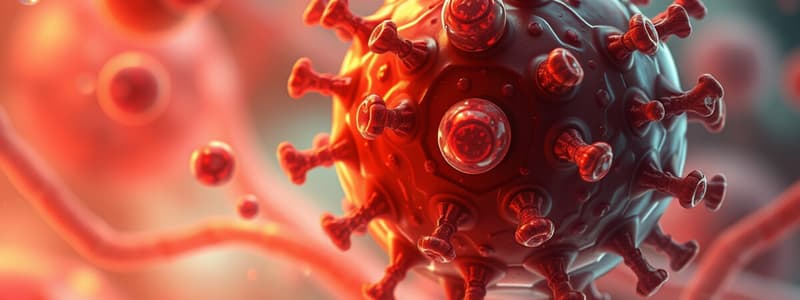Podcast
Questions and Answers
What is the antibiotic coverage chart?
What is the antibiotic coverage chart?
Antibiotic Coverage Chart
What is the antibiotic coverage table?
What is the antibiotic coverage table?
Antibiotic Coverage Table
What is the post-antibiotic effect (PAE)?
What is the post-antibiotic effect (PAE)?
Continued suppression of bacterial growth when antibiotic levels are below the MIC for the organism
List five antibiotic classes.
List five antibiotic classes.
List the time-dependent antibiotics T > MIC.
List the time-dependent antibiotics T > MIC.
List the concentration-dependent antibiotics AUC/MIC.
List the concentration-dependent antibiotics AUC/MIC.
List the concentration-dependent antibiotics Cmax/MIC.
List the concentration-dependent antibiotics Cmax/MIC.
What are cell wall synthesis inhibitors?
What are cell wall synthesis inhibitors?
What are the subclasses of B-lactams?
What are the subclasses of B-lactams?
What are glycopeptides?
What are glycopeptides?
What do cell membrane synthesis inhibitors do?
What do cell membrane synthesis inhibitors do?
List the protein synthesis inhibitors acting on the 30S and 50S ribosomal subunits.
List the protein synthesis inhibitors acting on the 30S and 50S ribosomal subunits.
What are folate synthesis inhibitors?
What are folate synthesis inhibitors?
What are nucleic acid synthesis inhibitors?
What are nucleic acid synthesis inhibitors?
What are the three main categories of antibiotic resistance?
What are the three main categories of antibiotic resistance?
Flashcards are hidden until you start studying
Study Notes
Antibiotic Coverage
- Antibiotic coverage charts and tables summarize the spectrum of activity for various antibiotics against different pathogens.
- Post-antibiotic effect (PAE) is the phenomenon where bacterial growth remains suppressed even after antibiotic levels drop below the Minimum Inhibitory Concentration (MIC).
Antibiotic Classes
- Cell Wall Synthesis Inhibitors: Prevent crosslinking of peptidoglycan, vital for bacterial cell wall integrity.
- Cell Membrane Inhibitors: Disrupt the bacterial cell membrane, leading to leakage of cellular contents.
- Protein Synthesis Inhibitors: Target ribosomal subunits (30S and 50S) to block protein production.
- Folate Synthesis Inhibitors: Interfere with folate metabolism essential for bacterial growth.
- Nucleic Acid Synthesis Inhibitors: Interfere with the synthesis of DNA and RNA.
Time-Dependent Antibiotics (T > MIC)
- Include Beta-lactams, Monobactams, Macrolides (except azithromycin), and Clindamycin.
Concentration-Dependent Antibiotics
- AUC/MIC: Vancomycin, Azithromycin, Tetracyclines, Linezolid.
- Cmax/MIC: Aminoglycosides, Fluoroquinolones, Metronidazole, Daptomycin.
Cell Wall Synthesis Inhibitors
- Beta-lactams: Include Penicillins, Cephalosporins, Carbapenems, and Monobactams (e.g., Aztreonam targets PBP in gram-negative bacteria).
- Glycopeptides: Critical members are Vancomycin, Telavancin, Dalbavancin, and Oritavancin.
Cell Membrane Synthesis Inhibitors
- Key drugs include Polymyxins and Daptomycin which compromise cell membrane integrity.
Protein Synthesis Inhibitors
- Act on ribosomal targets:
- 30S: Aminoglycosides, Tetracyclines.
- 50S: Macrolides, Clindamycin, Linezolid, Chloramphenicol, Quinupristin/dalfopristin, Glycylcyclines (Tigecycline).
Folate Synthesis Inhibitors
- Sulfonamides inhibit Dihydropteroate synthase, while Trimethoprim blocks Dihydrofolate reductase; commonly grouped as sulfamethoxazole/trimethoprim.
Nucleic Acid Synthesis Inhibitors
- Antibiotics include Fluoroquinolones, Metronidazole, Nitrofurantoin, and Rifamycin, targeting nucleic acid processes.
Antibiotics Resistance Mechanisms
- Inactivation of drug: Bacteria produce enzymes to destroy antibiotics.
- Decreased accumulation of drug: Reduced uptake or increased efflux mechanisms.
- Reduced binding to target: Mutations lead to lower affinity for the antibiotic’s target.
Studying That Suits You
Use AI to generate personalized quizzes and flashcards to suit your learning preferences.




